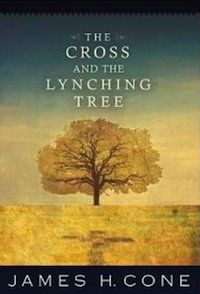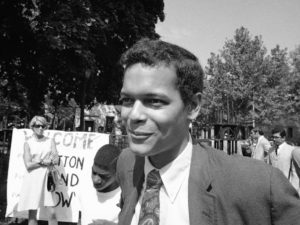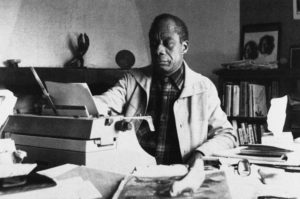God of the Oppressed
In this excerpt from “The Cross and the Lynching Tree,” James H. Cone writes that the gospel is found wherever the wronged struggle for justice.
Excerpted from “The Cross and the Lynching Tree” by James H. Cone.
To live meaningfully, we must see light beyond the darkness. As Mircea Eliade put it, “Life is not possible without an opening toward the transcendent.” The lynching era was the Heart of Darkness for the African American community. It was a tie when fragments of meaning were hard to find. Some found meaning in the blues and others in collective political resistance, but for many people it was religion that helped them to look beyond their tragic situation to a time when they would “cross the river of Jordan,” “lay down dat heavy load,” and “walk in Jerusalem just like John.”
The Christian gospel is God’s message of liberation in an unredeemed and tortured world. As such, it is a transcendent reality that lifts our spirits to a world far removed from the suffering of this one. It is an eschatological vision, an experience of transfiguration, such as Jesus experienced at his Baptism (Mk 1:9-11) or on Mt. Tabor (Mk 9:2-8), just before he set out on the road to Jerusalem, the road that led to Calvary. Paul had such a vision — “a light from heaven” — as he traveled the road to Damascus (Acts 9:3). Malcolm X, while in prison, had a vision of God, and so too did Martin King hear God speaking to him in his kitchen at a moment of crisis during the Montgomery bus boycott. For all four, the revelatory moment in their lives helped to prepare them to face their deaths, sustained by the conviction that this was not the end but the beginning of a new life of meaning. To paraphrase Eliade, once contact with the transcendent is found, a new existence in the world becomes possible.
And yet the Christian gospel is more than a transcendent reality, more than “going to heaven when I die, to shout salvation as I fly.” It is also an immanent reality — a powerful liberating presence among the poor right now in their midst, “building them up where they are torn down and propping them up on every leaning side.” The gospel is found wherever poor people struggle for justice, fighting for their right to life, liberty, and the pursuit of happiness. Bee Jenkins’s claim that “Jesus won’t fail you” was made in the heat of the struggle for civil rights in Mississippi, and such faith gave her strength and courage to fight for justice against overwhelming odds. Without concrete signs of divine presence in the lives of the poor, the gospel becomes simply an opiate; rather than liberating the powerless from humiliation and suffering, the gospel becomes a drug that helps them adjust to this world by looking for “pie in the sky.”
And so the transcendent and the immanent, heaven and earth, must be held together in critical, dialectical tension, each one correcting the limits of the other. The gospel is in the world, but it is not of the world; that is, it can be seen in the black freedom movement, but it is much more than what we see in our struggles for justice. God’s word is paradoxical, or, as the old untutored black preacher used to say, “inscrutable,” a mystery that one can neither control nor fully understand. It is here and not here, revealed and hidden at the same time. “Truly, you are a God who hides himself, O God of Israel, the Savior” (Isa 45:15).
Nowhere is that paradox, that “inscrutability,” more evident than in the cross. A symbol of death and defeat, God turned it into a sign of liberation and new life. The cross is the most empowering symbol of God’s loving solidarity with the “least of these,” the unwanted in society who suffer daily from great injustices. Christians must face the cross as the terrible tragedy it was and discover in it, through faith and repentance, the liberating joy of eternal salvation.
But we cannot find liberating joy in the cross by spiritualizing it, by taking away its message of justice in the midst of powerlessness, suffering, and death. The cross, as a locus of divine revelation, is not good news for the powerful, for those who are comfortable with the way things are, or for anyone whose understanding of religion is aligned with power. The religious authorities of Jesus’ time were threatened by his teachings about the reign of God’s justice and love, and the state authorities executed him as an insurrectionist — one who “perverts the nation” and “stirs up the people (Lk 23:2, 5). Even Jesus’ disciples misunderstood his teachings “that the Son of Man must undergo great suffering, and be rejected,” “mocked and flogged and crucified” (Mk 8:31; Mt 20:19). They slept through his agony in the Garden (Mk 14:32), and deserted him when he was arrested, tortured, and crucified. One disciple betrayed him and another denied him, because a suffering Messiah was not the one they expected. “We had hoped that he was the one to redeem Israel” (Lk 24:21).
This reversal of expectations and conventional values is the unmistakable theme of the gospel. “What is prized by human beings is an abomination in the sigh of God” (Lk 16:15). “All who exalt themselves will be humbled, but all who humble themselves will be exalted” (Lk 18:14). This “transvaluation of values,” as Niebuhr put it, finds its apotheosis in the cross. “In Jesus’ cross God took up the existence of a slave and died the slave’s death on the tree of martyrdom” (Phil 2:8). The cross, in Martin Hengel’s words points to God’s loving solidarity with the “unspeakable suffering of those who are tortured,” and “put to death by human cruelty. … In the person and fate of the one man Jesus of Nazareth this saving solidarity of God with [the oppressed] is given its historical and physical form.” “The cross,” writes Dorothy A. Lee-Pollard, “reveals where God’s kingdom is to be found — not among the powerful or even the religious, but in the midst of powerlessness, suffering and death.” Bonhoeffer was right: “The Bible directs [us] to God’s powerlessness and suffering. Only a suffering God can help.”
Great preachers preach the cross as the heart of the Christian message. The Apostle Paul preached the cross and transformed a Jewish sect into a faith for the world. Martin Luther preached the cross and started the Protestant Reformation. Karl Barth preached the cross and created a Copernican revolution in European theology. Reinhold Niebuhr preached the cross and developed a creative perspective on Christian social ethics in America. Fannie Lou Hamer sang and preached the cross and ignited a grassroots revolution in Mississippi. Martin Luther King Jr. preached the cross and transformed the social and political life in America, pointing to an American dream of justice, for which he gave his life.
One has to have a powerful religious imagination to see redemption in the cross, to discover life in death and hope in tragedy. What kind of salvation is that? No human language can fully describe what salvation through the cross means. Salvation through the cross is a mystery and can only be apprehended through faith, repentance, and humility. The cross is an “opening to the transcendent” for the poor who have nowhere else to turn — that transcendence of the spirit that no one can take away, no matter what they do. Salvation is broken spirits being healed, voiceless people speaking out, and black people empowered to love their own blackness.
And yet another type of imagination is necessary — the imagination to relate the message of the cross to one’s own social reality, to see that “They are crucifying again the Son of God” (Heb 6:6). Both Jesus and blacks were “strange fruit.” Theologically speaking, Jesus was the “first lynchee,” who foreshadowed all the lynched black bodies on American soil. He was crucified by the same principalities and powers that lynched black people in America. Because God was present with Jesus on the cross and thereby refused to let Satan and death have the last word about his meaning, God was also present at every lynching in the United States. God saw what whites did to innocent and helpless blacks and claimed their suffering as God’s own. God transformed lynched black bodies into the recrucified body of Christ. Every time a white mob lynched a black person, they lynched Jesus. The lynching tree is the cross in America. When American Christians realize that they can meet Jesus only in the crucified bodies in our midst, they will encounter the real scandal of the cross.
Excerpted from “The Cross and the Lynching Tree” by James H. Cone. Published by Orbis Books, 2011.
Your support is crucial…With an uncertain future and a new administration casting doubt on press freedoms, the danger is clear: The truth is at risk.
Now is the time to give. Your tax-deductible support allows us to dig deeper, delivering fearless investigative reporting and analysis that exposes what’s really happening — without compromise.
Stand with our courageous journalists. Donate today to protect a free press, uphold democracy and unearth untold stories.







You need to be a supporter to comment.
There are currently no responses to this article.
Be the first to respond.